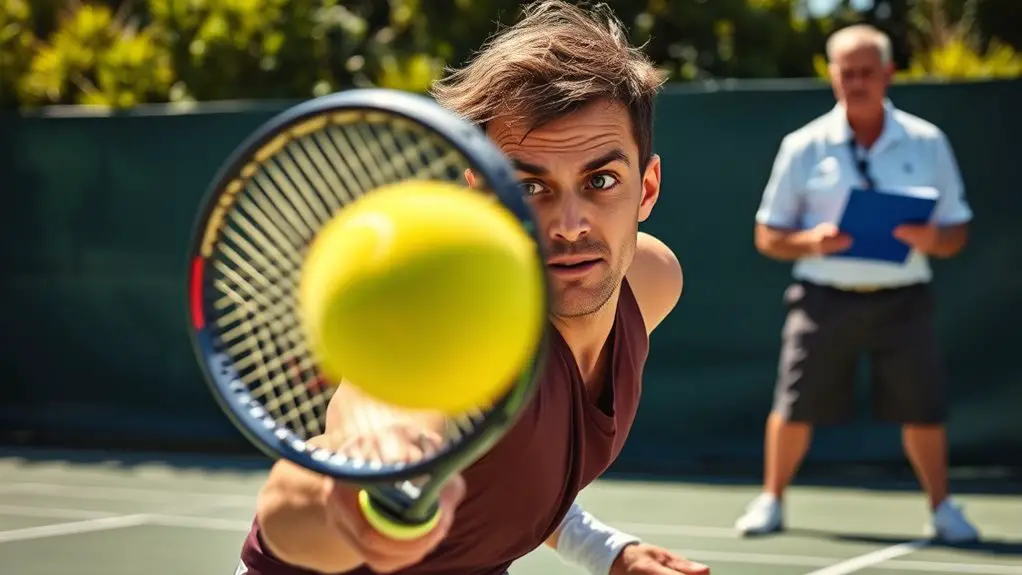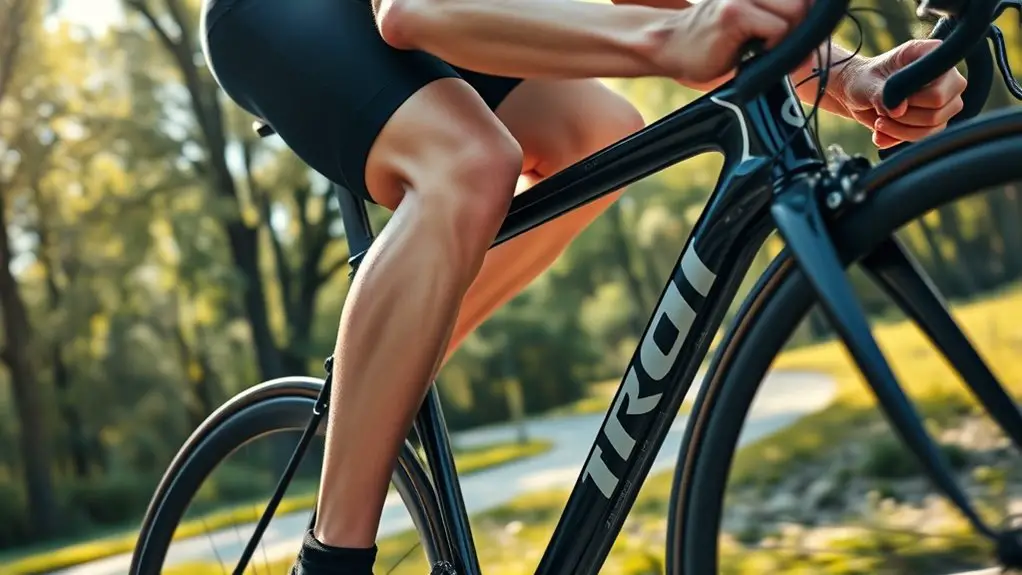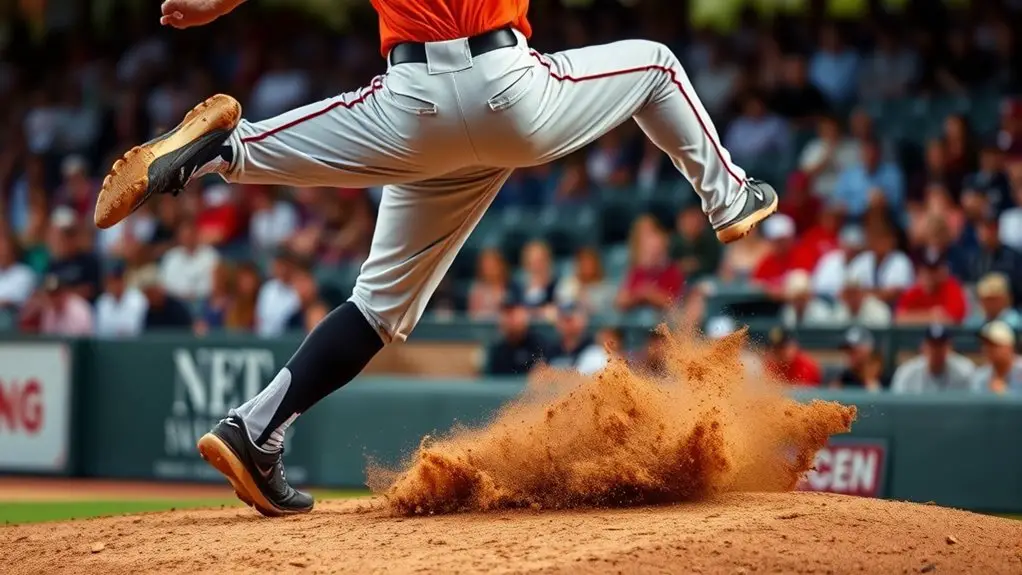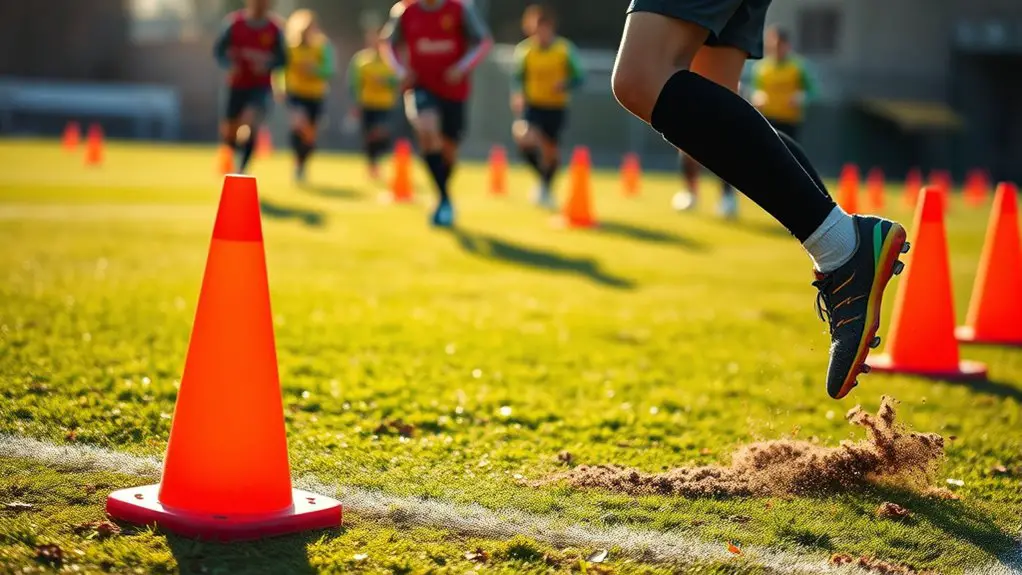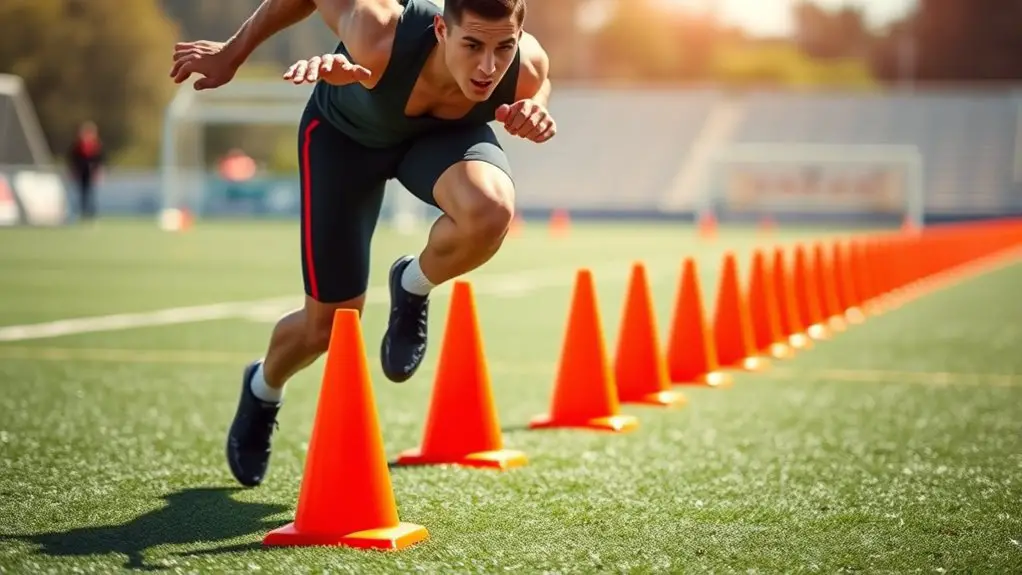To sharpen your reflexes for returning fast serves, focus on reaction ball drills to improve your hand-eye coordination and muscle memory. Partner toss and return practices help with timing and footwork. Try shadow play techniques to visualize your movements without a partner. Multi-ball drills mimic real match scenarios, increasing urgency and adaptability. Finally, use video analysis to spot weaknesses and improve your technique. If you explore further, you'll discover even more effective training strategies.
Reaction Ball Drills
When it comes to improving your reaction time for fast serves, reaction ball drills are a game-changer. These drills focus on enhancing your hand-eye coordination, allowing you to respond quicker to those rapid serves. By using a reaction ball, which bounces unpredictably, you'll challenge your reflexes like never before.
As you practice, you'll find yourself becoming more agile, adapting to the ball's erratic movements. This not only sharpens your focus but also builds muscle memory, so your body instinctively reacts faster during actual gameplay. Incorporating these drills into your routine gives you the freedom to express your skills on the court without hesitation. The more you push your limits, the more confident you'll feel in your ability to return those fast serves. Remember, it's not just about speed; it's about honing your reaction time to seize the moment and dominate the game. Additionally, consistent practice of these exercises leads to significant reflex improvements.
Partner Toss and Return
Get ready to elevate your reaction skills with the Partner Toss and Return drill. This exercise is all about honing your toss accuracy and mastering return timing, and it's perfect for players looking to up their game. Here's how it works:
- Grab a partner and stand a few feet apart.
- One of you tosses the ball toward the other, focusing on accuracy.
- The receiver practices quick footwork to position for the return.
- As you improve, increase the toss speed and vary the angles.
- Switch roles to challenge both players.
This drill not only sharpens your reflexes but also builds chemistry with your partner. By focusing on toss accuracy, you'll learn to anticipate the ball's path, while working on your return timing will help you strike with precision. Additionally, incorporating agility training techniques can further enhance your overall performance on the court. Get ready to feel the freedom of a well-timed return and elevate your game!
Shadow Play Techniques
Building on the skills developed in the Partner Toss and Return drill, Shadow Play Techniques are an excellent way to enhance your reaction time and movement without the need for a partner. By practicing shadow movements, you can visualize and simulate the returns you'd make against fast serves. This exercise allows you to focus on footwork patterns, helping you become more agile and responsive. Incorporating agility ladder drills into your routine can further improve your overall foot speed and coordination.
Here's a simple table to guide your practice:
| Shadow Movement | Footwork Pattern | Focus Area |
|---|---|---|
| Forehand Shadow | Side shuffle | Quick lateral movement |
| Backhand Shadow | Crossover step | Diagonal agility |
| Drop Shot Shadow | Quick step-in | Short distance speed |
| Lob Shadow | Backpedal | Rear court awareness |
Integrating these techniques into your routine will free you to react fluidly and confidently during matches.
Multi-Ball Drills
Multi-ball drills are a highly effective way to sharpen your reaction time and improve your ability to handle fast serves. By incorporating various multi-ball variations, you can challenge yourself and enhance your skills. Here's how to make the most of these drills:
- Vary the speed: Use balls thrown at different speeds to mimic real match scenarios.
- Target zones: Focus on specific areas of the court to improve your accuracy when returning serves.
- Change angles: Position the feeder at different angles to develop adaptability in your shots.
- Incorporate spins: Practice returning balls with various spins to build your versatility.
- Increase frequency: Ramp up the number of balls fed to create a sense of urgency and reaction.
Additionally, incorporating reaction ball drills can further improve your hand-eye coordination, making you even more adept at returning fast serves. This freedom to experiment with multi-ball drills allows you to tailor your training, ultimately making you a stronger competitor on the court.
Video Analysis for Improvement
While training hard is essential, using video analysis can greatly enhance your understanding of how to improve your reaction to fast serves. A video breakdown allows you to see your movements and decisions in real-time, making it easier to identify areas for growth. By reviewing your performance, you can gain valuable feedback that helps you refine your techniques.
Here's a quick overview of how to use video analysis effectively:
| Step | Action | Benefits |
|---|---|---|
| Record | Capture your practice sessions | Visual evidence of progress |
| Review | Analyze your movements closely | Identify specific weaknesses |
| Feedback | Get insights from coaches/peers | Objective perspective on growth |
| Implement | Apply learned adjustments in training | Improve reaction times |
Frequently Asked Questions
How Do I Improve My Overall Reaction Time?
To improve your overall reaction time, you can incorporate various training techniques into your routine. Focus on agility drills, like ladder exercises and quick sprints, to enhance your speed. Incorporate reaction-based games or sports that challenge your reflexes. Practicing mindfulness can help sharpen your focus, making it easier to respond quickly. Remember, consistency is key, so keep pushing yourself and enjoy the freedom that comes with improved reaction times!
What Equipment Is Best for Reaction Drills?
Did you know that athletes with superior reaction times can make decisions up to 0.2 seconds faster than their peers? For your reaction drills, consider investing in essential reaction equipment like agility ladders, reaction balls, and light-up targets. These training gear options can enhance your speed and coordination, giving you the freedom to move fluidly on the court. With the right tools, you'll access your potential and elevate your performance beyond limits.
How Often Should I Practice These Drills?
You should aim to practice your reaction drills at least three times a week. This frequency keeps your skills sharp without overwhelming you. Don't hesitate to mix in drill variations to keep things fresh and exciting. Whether it's different speeds or angles, variety can enhance your training experience. Listen to your body, and remember, it's about finding a rhythm that works for you while enjoying the process of improvement!
Can Beginners Benefit From These Drills?
You might think reaction drills are only for advanced players, but that's not true. Beginners can definitely benefit from these drills as they enhance skill development and build confidence on the court. By practicing reaction techniques, you'll improve your timing and anticipation, essential for handling fast serves. Plus, the freedom to express your style while mastering these skills makes the journey enjoyable and rewarding. So don't hesitate—get started and watch yourself grow!
What Common Mistakes Should I Avoid During Drills?
When you're practicing, avoid common mistakes like neglecting to focus on drill techniques and serve variations. It's easy to fall into a routine, but experimentation is key. If you don't challenge yourself with different serves, you might limit your growth. Also, don't rush through drills; take your time to guarantee proper form and understanding. Embrace the learning process, and remember, it's about enjoying your progress while refining your skills!
